/Vehicles/Axis/Germany/04-Panzerjaegers/Jagdtiger/File/Jagdtiger.htm | Last Up-date: 05-07-2019
Jagdpanzer VI Ausf.B Jagdtiger (Tank Destroyer)
Comme il en avait l'habitude, les Allemands étudièrent la possibilité de convertir le Tiger II en chasseur de charà champ de tir horizontal limité. Cette conversion fut initialement désignée Panzerjäger Tiger Ausf.B (Sd.Kfz.186) puis Jagdpanzer VI Ausf.B et devait à l'origine être doté du puissant 128mm Pak 80 sur superstructure blindée montée au centre de la caisse du Tigre-Royal.
As they had the practice of it, the Germans studied the possibility of converting Tiger II into hunter of tanks with limited horizontal field of fire. This conversion was initially indicated Panzerjäger Tiger Ausf.B (Sd.Kfz.186) then Jagdpanzer VI Ausf.B and had at the origin being equipped with powerful the 128mm Pak 80 on armoured superstructure assembled in the center of the hull of the King Tiger.
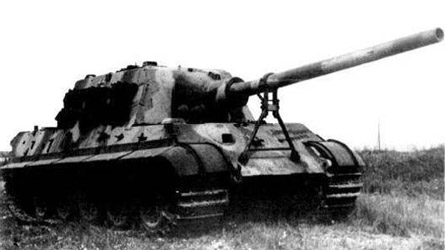 |
Jagdpanzer VI Ausf.B Jagdtiger |
src: Site WWII
Vehicles
|
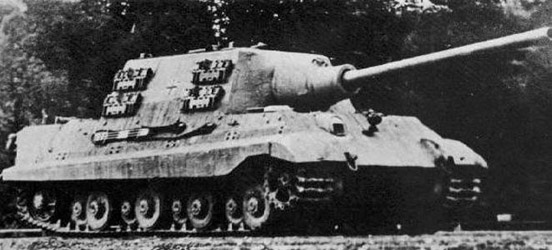 |
Porsche's prototype |
src: Site "Juggernauts
of the second world war"
|
Une maquette non blindée grandeur nature fut finalisée en octobre 1942 en même temps que le prototype du Tigre-Royal ! Le premier prototype fut prêt en avril 1944. Henschel et Krupp travaillèrent ensemble sur l'affût du canon muni d'un bouclier saukopf (groin de cochon). Le canon de 128 utilisait des projectiles en 2 parties (40 coups au total). Le très long 128mm Pak80 fut délaissé finalement au profit du plus court 128mm Pak 44 L/55. Le 128mm Pak 44 L/55 était supérieur à toute arme existante sur un char, tant du point de vue puissance et portée utile. Le blindage atteignait ici des proportions impressionnantes (250mm à l'avant). Les faces-à-faces étaient mortels à chaque coup pour ses adversaires ! Son armement secondaire était constitué de la mitrailleuse MG34 de caisse montée sur rotule comme sur le Tiger II et d'une autre MG34 anti-aérienne pouvant être monté sur un piquet métallique (démontable) sur le plateau arrière. Deux larges portes sur charnières étaient montées à l'arrière de la superstructure. Cette dernière remplaçait simplement la tourelle au centre de la caisse préservant ainsi les plateaux avant et arrière du Tiger II.
A not armoured full scale model was finalized in October 1942 at the same time as the prototype of the King Tiger! The first prototype was ready in April 1944. Henschel and Krupp worked together on the mounting of the gun provided with a saukopf shield(face mask of pig). The gun of 128 used projectiles in 2 parts (40 blows on the whole). The very long 128mm Pak80 was forsaken finally to the profit of the shortest 128mm Pak 44 L/55. The 128mm Pak 44 L/55 was superior to any weapon existing on a tank, so much from the point of view power and useful range. The armor reached impressive proportions here (250mm in front). The face-to-faces were mortals with each blow for its adversaries! Its secondary armament was consisted of machine-gun MG34 of hull assembled on ball as on Tiger II and of another anti-aircraft MG34 being able to be mount on a metal stake (dismountable) on the rear deck. Two broad gates on hinges were assembled to the back of the superstructure. The latter replaced simply the turret in the center of the hull thus preserving the front and rear decks of Tiger II.
128
mm Pak 44 L/55 Penetration of a shielding plate (mm) under a plunging angle of 30° |
|||||||
Ammo |
Weight |
Velocity |
100
m |
500 m |
1000
m |
1500 m |
2000
m |
| PzGr | 26.4 kg |
860 m/s |
189 |
166 |
143 |
127 |
117 |
PzGr 43 |
28.3 kg |
845 m/s |
187 |
178 |
167 |
157 |
148 |
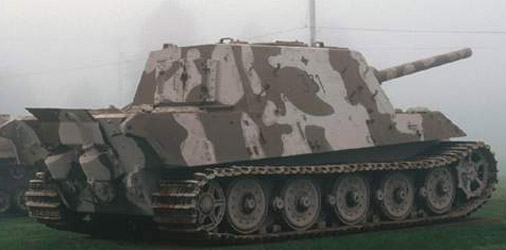 |
Jagdtiger (Aberdeen
Museum) |
|
|
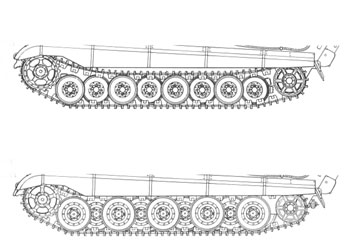 |
| Porsche and Henschel's suspensions. |
 |
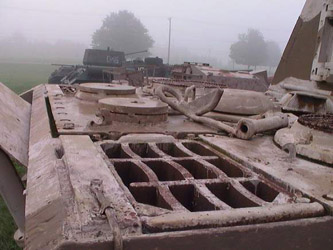 |
Jagdtiger
(Aberdeen Museum) |
|
|
|
|
Pour compenser le poids énorme (70 tonnes) la suspension fut rallongée de 26 cm. Un total de 150 exemplaires fut commandés. La production fut confiée à Steyr-Daimler-Puch à Saint-Valentin (Autriche). Ce total ne fut jamais atteint et moins de la moitié (70) furent finalement réalisés, la plupart en 1944 (48). En raison d'une interruption dans la livraison des 128 certains durent se contenter du 88mm Pak 43/3 du Jagdpanther mais l'idée ne fut pas réalisée. En février 1944, Hitler ordonna de rebaptiser le nouveau chasseur de char tout simplement "Jagdtiger".
To compensate the enormous weight (70 tons) suspension was lengthened of 26 cm. A total of 150 specimens was ordered. The production was entrusted to Steyr-Daimler-Puch of St.Valentin (Austria). This total was never reached and only the half (77) were finally realized, the majority in 1944 (48). Because of an interruption in the delivery of the 128 some had to be satisfied with the 88mm Pak 43/3 of Jagdpanther but the idea was not carried out. In February 1944, Hitler quite simply ordered renamed new hunter of tank " Jagdtiger ".
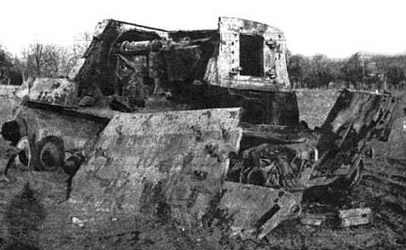 |
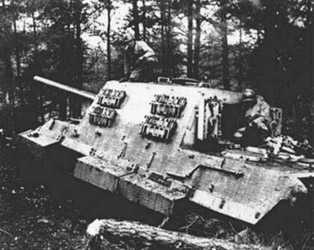 |
Jagdtiger pulverisé par une attaque aérienne. |
Jagdtiger abandonné et
examiné par des soldats américains |
| Jagdtiger completly destroyed by air atttack. |
Abandonned Jagdtiger,
examined by American soldiers |
src: Site "Juggernauts
of the second world war"
|
src: Site WWII
Vehicles
|
Porsche tenta d'améliorer la suspension du Jagdtiger en le dotant d'une suspension par boggies à barres de torsion et 8 galets à recouvrement longitudinal (au lieu de 9 pour la suspension Henschel). Porsche y monta également le moteur Porsche SLa 16 (type 212) Diesel de 700 ch. Seulement 1-2 exemplaires furent équipés de cette suspension. Le moteur du Jagdtiger étant toujours le Maybach HL 230 P30 conçu pour le Panther (45 tonnes !), il était sous-motorisé ne pouvant rouler (s'il ne voulait pas griller son moteur) qu'aux alentours des 17 km/h sur terrain dur.
Porsche tried to improve the suspension of Jagdtiger by equipping it with a suspension by bogie with torsion bars and 8 road wheels with longitudinal recovery (instead of 9 for the Henschel suspension). Porsche also mounted there the Porsche SLa 16 (type 212) Diesel engine of 700 hp. Only 1-2 specimens were equipped with this suspension. The engine of Jagdtiger being always Maybach HL 230 P30 conceived for the Panther (45 tons!), it was under-motorized not being able to run (if it did not want to roast its engine) only in the neighbourhoods of 17 km/h on hard ground.
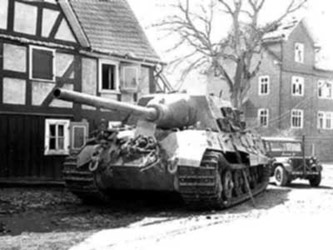 |
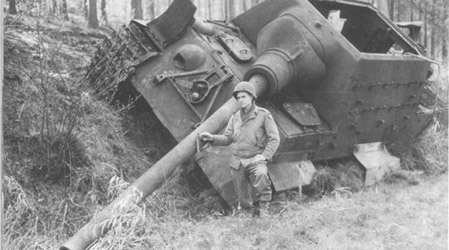 |
Jagdtiger abandonné dans une ville allemande. |
Jagdtiger du s.PzJg.abt.512, détruit
par un Sherman dans la forêt d'Offensen en Allemagne, le 9
avril 1945. |
| Jagdtiger abandonned in a German town. |
Jagdtiger of the s.PzJg.abt.512,
destroyed by a Sherman in the offensen woods in Germany, April 9
1945. |
src: Site
"Panzerwaffe" |
src: Tank Illustrated n°9
|
Le Jagdtiger fut mis au combat vers la fin de 1944 et servit jusqu'au terme du conflit. Le Jagdtiger était une arme redoutable en raison du calibre de son canon antichar mais des véhicules aussi lourds et imposants étaient des handicaps sur le plan tactique et purement des armes défensives, peu adaptées à la guerre en mouvement. Notons qu'à cette époque le seul choix de l'Allemagne était la défensive.
Jagdtiger was put at the combat towards the end of 1944 and was useful until the term of the conflict. Jagdtiger was a frightening weapon because of the gauge of its anti-tank gun but so heavy and imposing vehicles were handicaps on the tactical level and purely defensive weapons, little adapted to the mobile warfare. Let us note that at that time the only choice of Germany was the defensive.
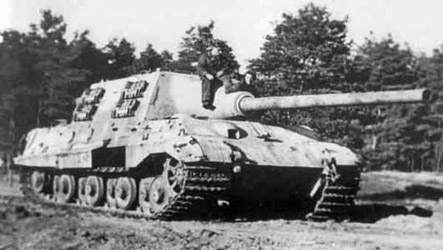 |
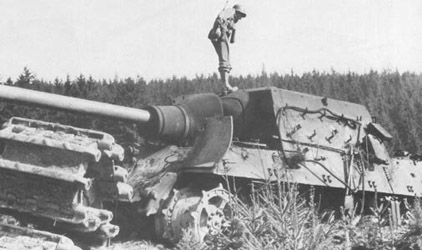 |
Le Jagdtiger, le roi des chasseurs de char. |
Jagdtiger abandonné, inspecté
par un soldat américain, près des montagnes Harz,
St-Adreasberg (Allemagne), le 16 avril 1945. |
Jagdtiger, the king of
the tank destroyers. |
Abandoned Jagdtiger, inspected
by an American soldier, close to the mountains Harz, St-Adreasberg
(Germany), April 16 1945. |
src: Site
"Panzerwaffe" |
src: Tank Illustrated n°9
|
Encore plus que le Tiger II, le Jagdtiger ne pouvait emprunter que des routes et des ponts solides et des passages assez larges. Les Jagdtigers furent versés dans des bataillons indépendants surtout au sein de la Waffen-SS et surtout utilisés pour appuyer les Pz.Divisions lors de l'offensive dans les Ardennes (sûrement son seul rôle offensif) et plus efficacement en position défensive, mais en pure perte lors de la bataille d'Allemagne.
Still more than Tiger II, Jagdtiger could borrow only solid roads and bridges and rather broad passages. Jagdtigers were versed in independent battalions especially within Waffen-SS and especially used to support Pz.Divisions at the time of the offensive in the Ardennes (surely its only offensive role) and more effectively in defensive position, but to no purpose at the time of the battle of Germany.
Data |
Drawings |
Sources:
- Tiger in action, Armor Number 27 (squadron/signal publications, inc.)
- Connaissance de l'Histoire (Hachette) - N°17 - " Les chars de combat allemands 39-45"
- Connaissance de l'Histoire (Hachette) - N°5 - " Véhicules blindés allemands 39-45"
- Les Blindés de la Seconde Guerre Mondiale (Atlas)
- Kingtiger Heavy Tank 1942-1945 (Osprey Military) - New Vanguard N°1
- Sturmartillerie & Panzerjäger 1939-1945 (Osprey Military) - New Vanguard N°34
- Site "Achtung Panzer" - http://www.achtungpanzer.com
- Site "WWII Vehicles" - http://www.wwiivehicles.com/germany/tank-hunters/jagdtiger.asp
- Site "Second World War Armour" - http://www.onwar.com/tanks/index.htm
/Jagdtiger-off.jpg)
/Bt-off.jpg)